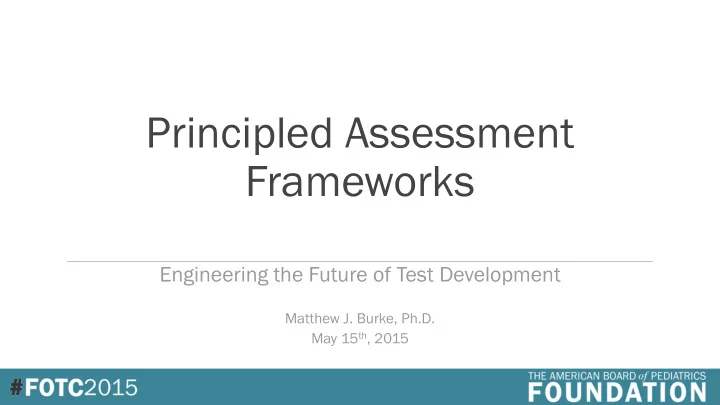

Principled Assessment Frameworks Engineering the Future of Test Development Matthew J. Burke, Ph.D. May 15 th , 2015
The future of testing is: • Reliably predicting and controlling the difficulty of test items…
Assessment Engineering • One of a class of principled assessment frameworks • Evidence-centered Design (Mislevy), Principled Design for Efficacy (Nichols), Principled Assessment Designs for Inquiry (IERI) • Comprehensive, model-based view of test development, administration, and scoring • Offers potential of both theoretical and practical improvements • Construct validity, Response processing validity • Item development, calibration, and scoring
Components of Assessment Engineering • Construct Map • Visual representation of the score scale • Demarcates ordered proficiency claims relative to the scale • Task Models • Aligned with the ordered proficiency claims • Each model represents a family of items providing comparable information • Templates • Item rendering blueprints • Provide instructions for producing item isomorphs
Components of Assessment Engineering: Accounting Specific Example Construct Map Task Models Item Templates Performance Task Models Item C1.xxx Claims : Template C 1 Item C1.002 Evaluates, interprets, Item C1.001 Rendering data researches, and analyzes XXX Scoring evaluator multivariable systems Template C 2 Task model data XXXX Apply(audit.procedure| Rendering data Prepare(audit.documentation, Scoring evaluator moderately complex)) XXXXX Template C 3 Task model data Rendering data XXXXXXX Scoring evaluator Template C 4 Task model data XXXXXXXXXXXX Connect(isolate(key Analyzes and interprets Rendering data components|moderately Item C4.xxx relationships between : XXXXXXXXXXXXXX Scoring evaluator complex issue, elements of a single system Task model data issue=inventory.context)) Item C4.002 XXXXXXXXXXX Item C4.001 Calculate(accruals|m XXXXXX oderately simple Template AA 1 financial statements) Computes multiple XXXXX Rendering data values from formulas Scoring evaluator Template AA 2 XXXX Task model data Classify(COGS components) Rendering data Defines basic XXX Scoring evaluator Template AA 3 accounting concepts Task model data Rendering data Item AA3.xxx Scoring evaluator : Task model data Decreasing Proficiency Item AA3.002 Item AA3.001 5
Defining a taxonomy of skills • Criteria of a cognitive taxonomy • Grain size, relevance, measurable, hierarchical * • Revised Bloom’s Taxonomy (Anderson et al., 2001) • Distilling the requisite skills • Cognitive task analysis (CTA) • Reverse-engineering • Structure of the skills • Hierarchical * , distinct, identifiable Putting it all together • Incorporation into test specifications, guidance of practice analysis
AE: Modified Skill/Content Specification
Related Research • Item difficulty modeling • Diehl, 2004; Embretson, 1998; Embretson and Daniel, 2008; Embretson and Gorin, 2001; Embretson and Wetzel, 1987; Gorin and Embretson, 2006 • Building/incorporating the infrastructure of AE • Luecht, 2015 * ; Luecht, 2013; Luecht, Burke and DeVore, 2009; Burke, DeVore, and Stopek, 2013; Burke and Stopek, 2013; Stopek and Burke, 2013; Burke, Stopek, and Eve, 2014; Furter, Burke, Morgan, and Kaliski, 2015 • Automatic item generation • Gierl, Lai, and Turner, 2012; Gierl and Lai, 2012; Alves, Gierl, and Lai, (2010); Gierl and Lai, ATP 2015 * • Automated test assembly • Van der Linden, 2006; Luecht, 1998 • Item family calibrations • Sinharay, Johnson, and Williamson, 2003; Glas and van der Linden, 2003; Geerlings, Glas, and van der Linden, 2011
Pros Con ons -Confirmatory, model-based approach to test -Extensive planning and preparation development -Potential overkill in some assessment settings -Strengthens validity argument -Increased cost of test development in the -Directed item development short term -Decreased cost of test development in the -Requires niche experts in test development long term and modeling -Reduced pre-testing demands -Requires flexibility in pilot testing -Standard setting/equating
Challenges • Changing existing processes that work • People are sometimes territorial • Measurement concerns often follow practical and policy concerns • Research is ongoing, work in progress • No off the shelf products exist, must be custom made • Doesn’t work in every case * Establishing buy-in Internal and external stakeholders We are saying this will be better, but they need to come to that conclusion on their own.
Recommend
More recommend